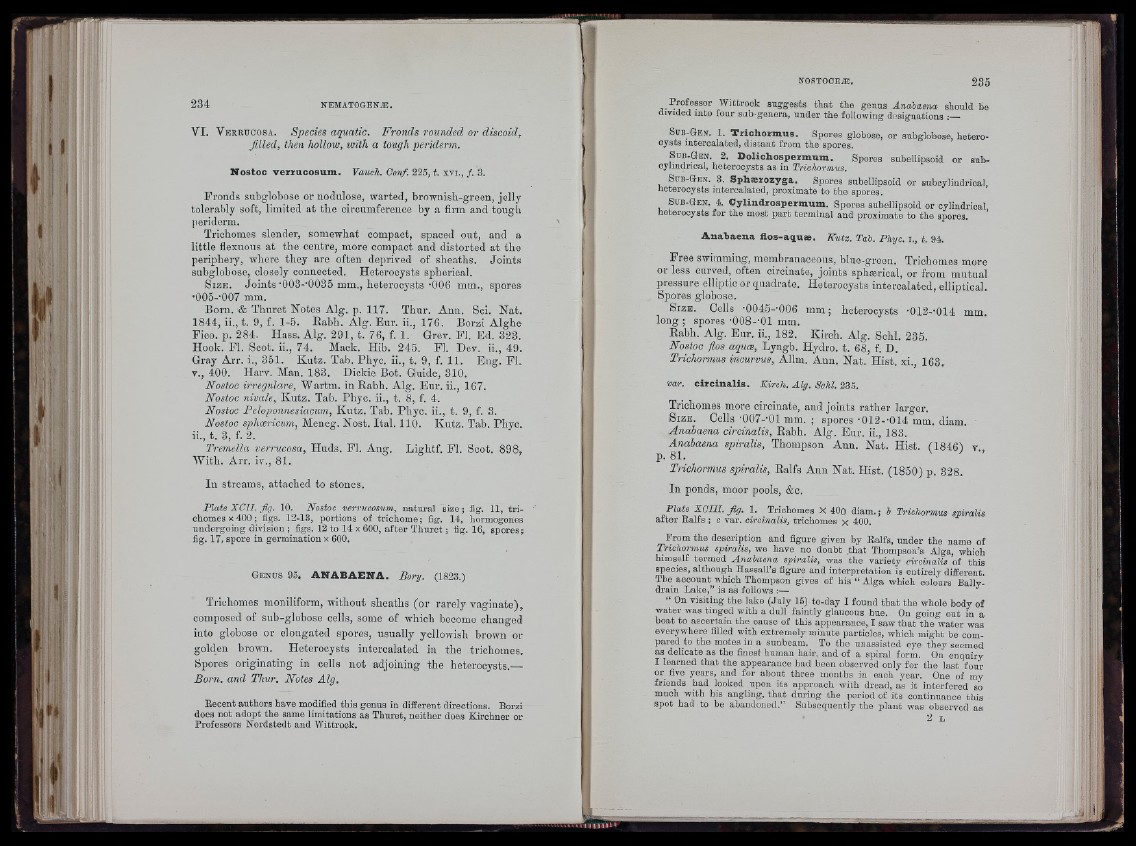
î
u
VI. V errucosa. Species aquatic. Fronds rounded or discoid,
filled, then hollow, with a tough periderm.
N o sto c v exzncosum. Vauch. Oonf. 225, t. xvi., /. 3.
Fronds subglobose or nodulose, warted, brownish-green, jelly
tolerably soft, limited at the circumference by a firm and tough
periderm.
Trichomes slender, somewhat compact, spaced out, and a
little flexuous a t the centre, more compact and distorted at the
periphery, where they are often deprived of sheaths. Jo in ts
subglobose, closely connected. Heterooysts spherical.
S iz e . Joints ’OOS-’OOSS mm., heterocysts -006 mm., spores
•005--007 mm.
Born. & Thuret Notes Alg. p. 117. Thur. Ann. Soi. Nat.
1844, ii.,t. 9, f. 1-5. Eabh. Alg. Eur. ii., 176. Borzi Alghe
Fico. p. 284. Hass. Alg. 291, t. 76, f. 1. Grev. El. Ed. 323.
Hook. Fl. Soot, ii., 74. Mack. Hib. 245. Fl. Dev. ii., 49.
Gray Arr. i., 351. Kutz. Tab. Phyc. ii., t. 9, f. 11. Eiig. F l.
V., 400. Harv. Man. 183. Dickie Bot. Guide, 310.
Nostoc irreguläre, Wartm. in Rabh. Alg. Eur. ii., 167.
Nostoc nivale, Kutz. Tab. Phyo. ii., t. 8 , f. 4.
Nostoc Peloponnesiacum, Kutz. Tab. Phyc. ii., t. 9, f. 3.
Nostoc sphæricum, Meneg. Nost. Ital. 110. Kutz. Tab. Phyo.
ii., t. 3, f. 2.
Tremella verrucosa, Huds. Fl. Ang. Lightf. Fl. Soot. 898,
W ith . Arr. iv., 81.
In streams, attached to stones.
Plate XCII. fig. 10. Nostoc verrtioosum, natural size ; fig. 11, trichomes
X 400 ; figs. 12-13, portions of trichome ; fig. 14, hormogones
undergoing division ; figs. 12 to 14 x 600, after Thuret ; fig. 16, spores;
fig. 17, spore in germination x 600.
Genus 95. A N A B A E N A . Bory. (1823.)
Trichomes moniliform, without sheaths (or rarely vaginate),
composed of sub-globose cells, some of which become changed
into globose or elongated spores, usually yellowish brown or
golden brown. Heterocysts intercalated in the trichomes.
Spores originating in cells not adjoining the heterocysts.—
Born, and Thur. Notes Alg.
Recent authors have modified this genus in different directions. Borzi
does not adopt the same limitations aa Thuret, neither does Kirchner or
Professors Nordstedt and Wittrock.
NOSTOOEÆ. 235
Professor Wittrock suggests that the genus Anabaena should be
divided into four sub-genera, under tbe following designations
Sub-Gen. 1. Txichoxmus. Spores globose, or subglobose, hetero-
c js ts intercalated, distant from the spores.
Sub-Gen. 2. Dolichospexmum. Spores subellinsoid or sub-
cylindrical, heterocysts as in Trichormus,
Sub-Gen. 3. Sphaexozyga. Spores subellipsoid or subcylindrical,
heterooysts intercalated, proximate to the spores.
Sub-Gen. 4. Cyliudxospexmum. Spores subellipsoid or cylindrical
heterooysts for the most p a rt terminal and proximate to the spores.
Anabaena flos-aquse. Kutz. Tab. Phyc. i., t. 94.
Free swimming, membranaceous, blue-green. Trichomes more
or less curved, often oiroinate, joints sphEerioal, or from mutual
pressure elliptic or quadrate. Heterooysts intercalated, elliptical.
Spores globose.
S iz e . Cells -OOdS-OOG m m ; heterocysts -012-'014 mm.
long ; spores -OOS-'Ol mm.
Eabh. Alg. Eur. ii., 182. Kiroh. Alg. Sohl. 235.
Nostoc flos aquce, Lyngb. Hydro, t. 68, f. D.
Trichormus incurvus, Alim. Ann. Na t. Hist, xi., 163.
var. c ix c in a lis. Kirch. Alg. Sohl. 235.
Trichomes more circinate, and joints rather larger.
S iz e . Cells •007--01 mm. ; spores -012--014 mm. diam. ■
Anabaena circinalis, Rabh. Alg. Eur. ii., 183.
Anabaena spiralis, Thompson Ann. Nat. Hist (1846) v
p. 81. ^ ^ ■’
Trichormus spiralis, Ralfs Ann Nat. Hist. (1850) p. 328.
In ponds, moor pools, &c.
J,/’*“!® fig . 1. Trichomes X 40o diam.; h Trichormus spiralis
after Kalfs ; c var. circmalis, trichomes x 100.
From the description and figure given by Ealfs, under the name of
Trichormus spiralis, we have no doubt that Thompson’s Alga, which
himself termed Anabaena spiralis, was the variety circinalis of this
species, although Hassall’s figure and interpretation is entirely different.
Tbe aooount which Thompson gives of his “ Alga which colours Bally-
drain Lake,” is as follows ;—
“ On visiting the lake (July 15) to-day I found that the whole body of
water was tinged with a dull faintly glaucous hue. On going out in a
boat to ascertain the cause of this appearance, I saw that the water was
everywhere filled with extremely minute particles, which might be compared
to the motes in a sunbeam. To the unassisted eye they seemed
as delicate as the finest human hair, and of a spiral form. On enquiry
I learned that the appearance had been observed only for the last four
or five years, aud for about three months in each year. One of my
friends had looked upon its approach with dread, as it interfered so
much with his angling, that during the period of its continuance this
spot had to be abandoned.” Subsequently the plant was observed as
2 L